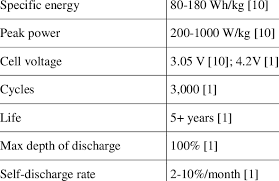
Lithium Ion Batteries Properties: materials represent a rapidly growing area in the field of Li-ion batteries
because of their substantial advantages in terms of mass transport. Transport in nanoparticle systems typically
encompasses shorter transport lengths for both electrons and Li+ ions, higher electrode–electrolyte contact
area, better accommodation of the strain of Li+ insertion/extraction, and in some cases also local anomalies.
Therefore, elaborate nanocomposites generally show higher reversible capacity, and better cycling behavior than
their simpler antecedents. The large surface/volume ratio and the congruence of the carrier screening length
make nanocomposites efficient electrode materials for powerful electrochemical energy storage devices with
both high energy density and high power density, due to the pronounced size effects, dimensional confinement,
and the reduction of the Li+ diffusion length. Of such nanomaterials, Si-based nanocomposites, nanostructured
TiO2, and SnO2 nanomaterials have received a great deal of attention, and are considered as alternative anode
materials.
Lithium Ion Batteries Properties: (1D) nanostructures, Nanowires/rods, are perfect building blocks for functional
nanodevices and efficient electron and exciton transport. Commonly, electrical conductivity is one of the most
important factors affecting the utilization of active materials and the internal resistance of the electrode.
Therefore, synthesis of one-dimensional nanostructures of higher electrical conductivity is highly desirable in the
field of nanoelectrode materials. Recently, several techniques for the synthesis of metal oxide-metal composites
become available. The composites have a stronger ability to promote electron transfer than metal oxide because
of inner electric metal, which is in the centre of the composite. As the result, the composites could supply more
efficient transport passage for the electrochemical processes.
Lithium Ion Batteries Properties: the development of nanoscience, it is reasonable to expect that the ability to
process nanostructure metal oxide into nanostructure mother metal materials. This could enrich our
understanding of its fundamental properties and enhance its performance in currently existing applications. In
recent years, cupric oxide (CuO) nanostructures have attracted great interest because of their fundamental
importance and promising applications into electro chromic devices, optical switching, solar cells,
heterogeneous catalysis, photo catalysis, gas sensing, field emission, lithium batteries and so on. With advantages of high theoretical capacity (670 mAh g-1), improved safety than graphite, low cost and environmental benignity, CuO is a very appealing candidate for the substitution of a conventional graphite anode in lithium ion batteries
Lithium Ion Batteries Properties: CuO not only enables easy diffusion of Li ions, the strain associated with Li
uptake could also be well accommodated, contributing to better electrochemical cycling performance. Several
groups have successfully synthesized CuO nanostructures onto bulk copper foil or other bulk materials, however,
there is only single face of the bulk substrates to grow CuO nanostructures and assemble advanced application
device. This assembly has relative lower surface area of CuO nanostructures. The novel characteristics that are
always acquired from nanostructure CuO might be strongly influenced by the bulk substrates or other
nonelectric substrates properties because they can grow only on the bulk substrate. Hence, to find a facile, mild
way to grow CuO nanostructures on the Cu nanostructures and extend their applications are of great scientific
and technological significance
Lithium Ion Batteries Properties: we used glucose, one of the bio molecules, to assist the synthesis of brand
new puzzle-like copper superstructures and applied them to no enzymatic glucose sensors. In this work, we use
these copper superstructures to calcine under different temperatures. A new structured composite, CuO
Nanorods on double-face Cu micro puzzles is obtained. These CuO-Cu superstructures composites can be used
as lithium ion battery anode materials. The electrodes containing CuO Nanorods on double-face Cu micro
puzzles exhibited an electrochemical capacity of > 640 mA h g-1, and satisfactory electrochemical stability up to
300 charge–discharge cycles.
